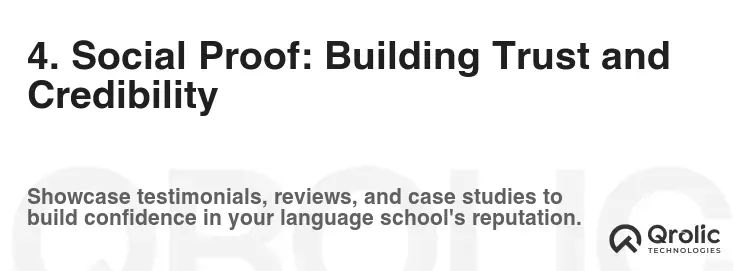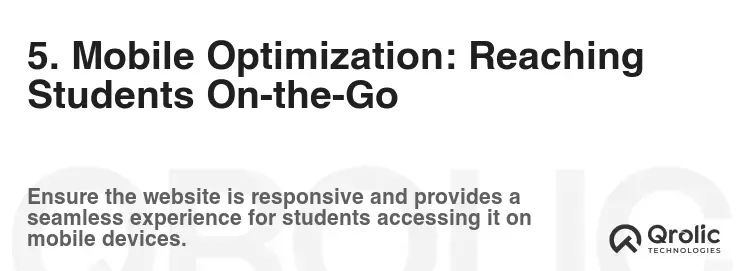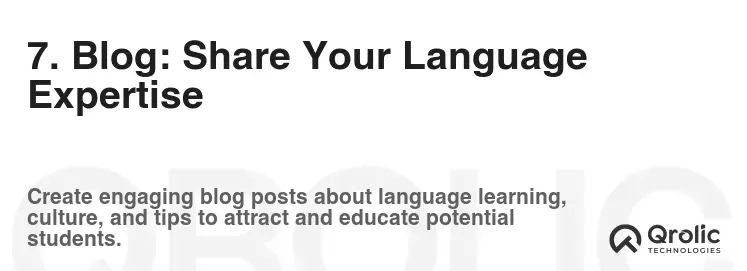Table of Contents
- 1. Compelling Homepage: Your Digital Welcome Mat
- 1.1. Above-the-Fold Magnetism: Hooking Visitors Instantly
- 1.2. Value Proposition: Show, Don’t Just Tell
- 1.3. Intuitive Navigation: Guiding Visitors Seamlessly
- 2. Course Catalog: Showcase Your Language Offerings
- 2.1. Detailed Course Descriptions: Paint a Vivid Picture
- 2.2. Level Assessment: Helping Students Find the Right Fit
- 2.3. Course Scheduling: Flexibility and Convenience
- 3. Lead Generation: Turning Visitors into Students
- 3.1. Contact Forms: Easy Communication
- 3.2. Free Resources: Offering Value Upfront
- 3.3. Live Chat: Instant Support
- 4. Social Proof: Building Trust and Credibility
- 4.1. Testimonials: Real Student Voices
- 4.2. Case Studies: Showcasing Success Stories
- 4.3. Social Media Integration: Staying Connected
- 5. Mobile Optimization: Reaching Students On-the-Go
- 5.1. Responsive Design: Adapting to All Devices
- 5.2. Mobile-Friendly Navigation: Easy to Use on Small Screens
- 5.3. Fast Loading Speed: Keeping Users Engaged
- 6. SEO Optimization: Getting Found Online
- 6.1. Keyword Research: Targeting the Right Terms
- 6.2. On-Page Optimization: Making Content Search-Engine Friendly
- 6.3. Off-Page Optimization: Building Authority and Trust
- 7. Blog: Share Your Language Expertise
- 7.1. Valuable Content: Addressing Student Needs
- 7.2. Keyword Integration: Boosting SEO
- 7.3. Engaging Format: Keeping Readers Hooked
- 8. About Us Page: Building a Personal Connection
- 8.1. School Story: Sharing Your Mission
- 8.2. Instructor Profiles: Showcasing Expertise
- 8.3. School Culture: Showcasing the Community
- 9. Qrolic Technologies: Your Partner in Digital Success
- 10. Constant Optimization and Analysis: Staying Ahead of the Curve
- 10.1. Website Analytics: Tracking Performance
- 10.2. A/B Testing: Optimizing for Conversions
- 10.3. Staying Updated: Adapting to Change
1. Compelling Homepage: Your Digital Welcome Mat

1.1. Above-the-Fold Magnetism: Hooking Visitors Instantly
Imagine your homepage as the friendly face greeting students walking into your language school. You only have a few seconds to make a fantastic first impression. The “above-the-fold” area – what visitors see before scrolling – is prime real estate.
-
What: This section needs a captivating headline that instantly addresses the visitor’s needs and aspirations. Think “Unlock Your Fluency,” “Speak Confidently in [Target Language],” or “Your Gateway to Global Communication.”
-
Why: Humans are visual creatures. A professionally designed hero image or video showing smiling students engaged in learning creates a positive emotional connection. Showcase the energy and vibrancy of your school.
-
How: Use high-quality images or video. Keep text concise and impactful. Include a clear call to action (CTA) button like “Explore Courses,” “Get a Free Assessment,” or “Download Our Brochure.” The design should be clean, uncluttered, and responsive – adapting flawlessly to different devices.
-
When: Optimize this section regularly. Analyze website analytics to see what elements resonate most with visitors and adjust accordingly. A/B test different headlines, images, and CTAs to maximize conversions.
-
Benefits: A strong above-the-fold section significantly increases engagement, reduces bounce rate, and encourages visitors to explore the rest of your website. It builds trust and establishes your school as a credible and welcoming learning environment.
1.2. Value Proposition: Show, Don’t Just Tell
Don’t just state that you offer language courses. Show potential students what makes your school special.
-
What: Clearly articulate your unique selling proposition (USP). What sets you apart from the competition? Is it your innovative teaching methods, experienced instructors, cultural immersion activities, or personalized learning plans?
-
Why: Students have options. They need to understand why they should choose your school over others. Highlighting your value proposition demonstrates the tangible benefits they will receive.
-
How: Use benefit-driven language. Instead of saying “We offer small class sizes,” say “Enjoy personalized attention and faster progress with our small class sizes.” Use testimonials and social proof to validate your claims. Feature compelling statistics, like “95% of our students achieve fluency within one year.”
-
When: Revisit and refine your value proposition regularly. Market trends and student needs change, so your messaging should evolve to stay relevant and competitive.
-
Steps:
- Identify your target audience’s pain points and aspirations.
- List the unique benefits your school offers.
- Craft a concise and compelling value proposition that addresses those pain points and highlights those benefits.
- Test and refine your messaging based on data and feedback.
1.3. Intuitive Navigation: Guiding Visitors Seamlessly
A confusing website is a guaranteed way to lose potential students. Make it easy for them to find what they’re looking for.
-
What: Implement clear and intuitive navigation menus. Use straightforward labels like “Courses,” “About Us,” “Admissions,” “Contact,” and “Blog.” Ensure the navigation is consistent across all pages.
-
Why: User experience (UX) is crucial for engagement and conversions. Easy navigation keeps visitors on your site longer, increasing the likelihood that they will inquire about your programs.
-
How: Use a logical site structure. Group related content together. Implement breadcrumbs to help users understand their location within the site. Include a search bar for quick access to specific information. Optimize for mobile devices with a responsive navigation menu.
-
When: Regularly test your navigation with real users to identify any usability issues. Conduct user testing to observe how people interact with your website and identify areas for improvement.
-
Benefits: Improved user experience, reduced bounce rate, increased time on site, and higher conversion rates. Students are more likely to explore your offerings and contact you if they can easily find what they need.
2. Course Catalog: Showcase Your Language Offerings

2.1. Detailed Course Descriptions: Paint a Vivid Picture
Each course description should be more than just a list of topics. It should paint a vivid picture of the learning experience.
-
What: Provide comprehensive information about each course, including the level (beginner, intermediate, advanced), the target language skills (speaking, listening, reading, writing), the learning objectives, the course duration, the schedule, and the price.
-
Why: Students need to understand exactly what they will gain from each course and how it will help them achieve their language learning goals. Detailed descriptions build trust and reduce uncertainty.
-
How: Use clear and concise language. Avoid technical jargon. Use bullet points to highlight key benefits. Include a syllabus or course outline to provide a detailed overview of the content. Add images or videos of students participating in the course.
-
When: Regularly update course descriptions to reflect any changes in content, schedule, or pricing. Ensure the information is accurate and up-to-date.
-
Benefits: Increased student enrollment, reduced inquiries about course details, and improved student satisfaction.
2.2. Level Assessment: Helping Students Find the Right Fit
Placing students in the appropriate level is crucial for their success.
-
What: Offer a free online level assessment test to help students determine their current language proficiency. This can be a multiple-choice test, a short writing sample, or a brief oral assessment.
-
Why: Students who are placed in courses that are too easy or too difficult are likely to become discouraged and drop out. A level assessment ensures that students are learning at the appropriate pace and achieving their goals.
-
How: Use a validated language assessment tool. Provide clear instructions and feedback. Offer personalized course recommendations based on the assessment results.
-
When: Encourage all prospective students to take the level assessment before enrolling in a course. Promote the assessment prominently on your website.
-
Benefits: Improved student retention, increased student satisfaction, and more effective learning outcomes.
2.3. Course Scheduling: Flexibility and Convenience
Make it easy for students to find courses that fit their busy schedules.
-
What: Implement a user-friendly course scheduling system that allows students to browse courses by level, language, schedule, and instructor. Allow them to filter and sort courses based on their preferences.
-
Why: Students are increasingly looking for flexible and convenient learning options. A well-designed course scheduling system can attract more students and increase enrollment.
-
How: Use a calendar view to display course schedules. Allow students to register for courses online. Send automated reminders about upcoming classes.
-
When: Keep the course schedule up-to-date and accurate. Regularly solicit feedback from students about the scheduling system.
-
Benefits: Increased student enrollment, improved student satisfaction, and reduced administrative workload. Streamlined course registration process.
3. Lead Generation: Turning Visitors into Students

3.1. Contact Forms: Easy Communication
Make it easy for potential students to contact you with questions or inquiries.
-
What: Include contact forms on multiple pages of your website, such as the homepage, course pages, and contact page. Keep the forms short and simple, asking only for essential information like name, email address, and phone number.
-
Why: Contact forms provide a convenient way for students to reach out to you without having to search for your email address or phone number. They also allow you to collect valuable lead information.
-
How: Use clear and concise form labels. Include a privacy policy to assure students that their information will be kept confidential. Use a CAPTCHA to prevent spam submissions.
-
When: Monitor your contact forms regularly to ensure that you are responding to inquiries promptly. Analyze form submissions to identify common questions and areas for improvement on your website.
-
Benefits: Increased lead generation, improved customer service, and valuable insights into student needs.
3.2. Free Resources: Offering Value Upfront
Provide valuable free resources to attract potential students and establish your school as a thought leader.
-
What: Offer free language learning resources such as e-books, guides, checklists, webinars, and sample lessons. These resources should be relevant to your target audience and provide practical advice and tips.
-
Why: Free resources attract potential students to your website and provide them with a taste of your teaching style and expertise. They also allow you to collect valuable lead information in exchange for the resources.
-
How: Create high-quality, informative content that is relevant to your target audience. Promote your free resources prominently on your website and social media channels. Use a lead capture form to collect email addresses in exchange for the resources.
-
When: Regularly update your free resources to keep them fresh and relevant. Track the performance of your resources to identify which ones are most popular and generate the most leads.
-
Benefits: Increased website traffic, lead generation, and brand awareness. Establishes your school as an authority in language education.
3.3. Live Chat: Instant Support
Offer live chat support to provide instant assistance to potential students.
-
What: Implement a live chat feature on your website that allows visitors to communicate with a customer service representative in real time.
-
Why: Live chat provides a convenient way for potential students to get their questions answered quickly and easily. It can also help to overcome objections and close sales.
-
How: Use a reputable live chat platform. Train your customer service representatives to provide excellent customer service. Be responsive and helpful.
-
When: Monitor your live chat activity regularly to ensure that you are providing timely and effective support. Analyze chat transcripts to identify common questions and areas for improvement on your website.
-
Benefits: Increased lead generation, improved customer service, and higher conversion rates. Provides immediate assistance and builds rapport with potential students.
4. Social Proof: Building Trust and Credibility

4.1. Testimonials: Real Student Voices
Showcase positive testimonials from satisfied students.
-
What: Collect testimonials from students who have had a positive experience at your school. Include their name, photo, and a brief quote about their experience.
-
Why: Testimonials provide social proof that your school delivers on its promises. They help to build trust and credibility with potential students.
-
How: Ask satisfied students to provide testimonials. Make it easy for them to submit their feedback. Feature testimonials prominently on your website, such as on the homepage, course pages, and testimonials page.
-
When: Regularly collect and update your testimonials. Ensure that the testimonials are authentic and representative of the student experience.
-
Benefits: Increased trust and credibility, higher conversion rates, and improved brand reputation.
4.2. Case Studies: Showcasing Success Stories
Share detailed case studies that highlight the success of your students.
-
What: Develop case studies that showcase how your school has helped students achieve their language learning goals. Include details about the student’s background, their goals, the challenges they faced, and the results they achieved.
-
Why: Case studies provide compelling evidence of the effectiveness of your programs. They demonstrate the tangible benefits that students can expect to receive.
-
How: Identify students who have achieved significant success. Interview them to gather information for the case study. Present the information in a clear and engaging format.
-
When: Regularly develop and publish new case studies. Promote them prominently on your website and social media channels.
-
Benefits: Increased trust and credibility, higher conversion rates, and improved brand reputation. Provides concrete examples of the value your school offers.
4.3. Social Media Integration: Staying Connected
Integrate your social media feeds into your website to showcase your online community and engagement.
-
What: Embed your social media feeds (e.g., Facebook, Instagram, Twitter) on your website. This allows visitors to see your latest posts, photos, and videos.
-
Why: Social media integration provides social proof and demonstrates that your school is active and engaged online. It also encourages visitors to follow you on social media.
-
How: Use social media widgets to embed your feeds on your website. Choose a visually appealing layout. Regularly update your social media channels with fresh and engaging content.
-
When: Monitor your social media feeds regularly to ensure that the content is appropriate and up-to-date. Respond to comments and messages promptly.
-
Benefits: Increased social media followers, improved brand awareness, and enhanced engagement with potential students.
5. Mobile Optimization: Reaching Students On-the-Go

5.1. Responsive Design: Adapting to All Devices
Ensure that your website is responsive and adapts seamlessly to all devices, including smartphones, tablets, and desktops.
-
What: Use a responsive design framework to build your website. This ensures that the layout, content, and navigation adjust automatically to the screen size of the device being used.
-
Why: Mobile devices account for a significant portion of website traffic. A responsive website provides a better user experience for mobile users and increases the likelihood that they will engage with your content.
-
How: Use a responsive design framework such as Bootstrap or Foundation. Test your website on different devices to ensure that it is displaying correctly.
-
When: Regularly test your website on new devices as they are released. Update your responsive design framework as needed.
-
Benefits: Improved user experience, increased mobile traffic, and higher conversion rates.
5.2. Mobile-Friendly Navigation: Easy to Use on Small Screens
Optimize your website navigation for mobile devices.
-
What: Use a mobile-friendly navigation menu that is easy to use on small screens. Consider using a hamburger menu (three horizontal lines) to collapse the navigation menu into a compact space.
-
Why: Mobile navigation can be challenging due to the limited screen size. A well-designed mobile navigation menu makes it easy for users to find what they are looking for.
-
How: Use a mobile-friendly navigation menu plugin or framework. Test your navigation on different mobile devices.
-
When: Regularly test your navigation on new mobile devices as they are released.
-
Benefits: Improved user experience, increased mobile engagement, and higher conversion rates.
5.3. Fast Loading Speed: Keeping Users Engaged
Optimize your website for fast loading speed on mobile devices.
-
What: Optimize images, minify code, and use a content delivery network (CDN) to improve your website’s loading speed.
-
Why: Mobile users are often on slow or unreliable internet connections. A slow-loading website can frustrate users and cause them to abandon your site.
-
How: Use a website speed testing tool to identify areas for improvement. Optimize images by compressing them without sacrificing quality. Minify code by removing unnecessary characters and whitespace. Use a CDN to distribute your website’s content to servers around the world.
-
When: Regularly test your website’s loading speed and make adjustments as needed.
-
Benefits: Improved user experience, increased mobile engagement, and lower bounce rates.
6. SEO Optimization: Getting Found Online

6.1. Keyword Research: Targeting the Right Terms
Conduct thorough keyword research to identify the terms that potential students are using to search for language schools online.
-
What: Use keyword research tools such as Google Keyword Planner, SEMrush, and Ahrefs to identify relevant keywords with high search volume and low competition.
-
Why: Keyword research helps you to understand what potential students are looking for and to optimize your website content to rank higher in search results.
-
How: Identify keywords related to your language school, your courses, and your target audience. Analyze the search volume, competition, and relevance of each keyword. Create a list of target keywords to use in your website content.
-
When: Regularly conduct keyword research to stay up-to-date with the latest search trends.
-
Benefits: Increased website traffic, improved search engine rankings, and higher conversion rates.
6.2. On-Page Optimization: Making Content Search-Engine Friendly
Optimize your website content for your target keywords.
-
What: Use your target keywords in your website titles, headings, meta descriptions, and body text. Optimize your images with alt tags that include your target keywords.
-
Why: On-page optimization helps search engines to understand what your website is about and to rank it higher in search results.
-
How: Use your target keywords naturally and sparingly throughout your website content. Avoid keyword stuffing, which can negatively impact your search engine rankings.
-
When: Regularly review and update your website content to ensure that it is optimized for your target keywords.
-
Benefits: Improved search engine rankings, increased website traffic, and higher conversion rates.
6.3. Off-Page Optimization: Building Authority and Trust
Build high-quality backlinks from other websites to increase your website’s authority and trust.
-
What: Earn backlinks from other websites by creating valuable content that people want to link to. You can also participate in industry forums, guest blog on other websites, and submit your website to online directories.
-
Why: Backlinks are a signal to search engines that your website is a valuable and trustworthy resource. Websites with more backlinks tend to rank higher in search results.
-
How: Create high-quality, informative content that is relevant to your target audience. Promote your content on social media and other channels. Reach out to other websites and bloggers to ask for backlinks.
-
When: Regularly work on building new backlinks to your website.
-
Benefits: Improved search engine rankings, increased website traffic, and higher conversion rates.
7. Blog: Share Your Language Expertise

7.1. Valuable Content: Addressing Student Needs
Create a blog that provides valuable content for potential and current students.
-
What: Write blog posts about language learning tips, cultural insights, grammar lessons, vocabulary building, and other topics that are relevant to your target audience.
-
Why: A blog helps you to attract potential students to your website, establish your school as a thought leader, and improve your search engine rankings.
-
How: Create a content calendar to plan your blog posts. Write high-quality, informative content that is engaging and easy to read. Promote your blog posts on social media and other channels.
-
When: Regularly publish new blog posts to keep your website fresh and engaging.
-
Benefits: Increased website traffic, lead generation, improved search engine rankings, and enhanced brand reputation.
7.2. Keyword Integration: Boosting SEO
Incorporate relevant keywords into your blog posts to improve your search engine rankings.
-
What: Use your target keywords in your blog post titles, headings, and body text. Optimize your images with alt tags that include your target keywords.
-
Why: Keyword integration helps search engines to understand what your blog posts are about and to rank them higher in search results.
-
How: Use your target keywords naturally and sparingly throughout your blog posts. Avoid keyword stuffing, which can negatively impact your search engine rankings.
-
When: Regularly review and update your blog posts to ensure that they are optimized for your target keywords.
-
Benefits: Improved search engine rankings, increased website traffic, and higher conversion rates.
7.3. Engaging Format: Keeping Readers Hooked
Use an engaging format to keep readers hooked on your blog posts.
-
What: Use short paragraphs, bullet points, images, videos, and other visual elements to break up the text and make your blog posts more engaging.
-
Why: An engaging format helps to keep readers interested in your blog posts and encourages them to spend more time on your website.
-
How: Use a variety of visual elements to break up the text. Use headings and subheadings to organize your content. Write in a clear and concise style.
-
When: Regularly experiment with different formats to see what works best for your audience.
-
Benefits: Increased time on site, lower bounce rates, and higher conversion rates.
8. About Us Page: Building a Personal Connection

8.1. School Story: Sharing Your Mission
Tell the story of your language school.
-
What: Share the history of your school, your mission, your values, and your unique approach to language education.
-
Why: Your story helps potential students to connect with your school on a personal level and to understand what makes you different from other language schools.
-
How: Write a compelling narrative that is authentic and engaging. Include photos and videos to bring your story to life.
-
When: Regularly review and update your school story to ensure that it reflects your current mission and values.
-
Benefits: Increased trust and credibility, higher conversion rates, and improved brand reputation.
8.2. Instructor Profiles: Showcasing Expertise
Highlight your instructors’ qualifications and experience.
-
What: Create profiles for each of your instructors that include their name, photo, qualifications, experience, teaching philosophy, and a brief bio.
-
Why: Instructor profiles help potential students to get to know your instructors and to feel confident that they are learning from qualified professionals.
-
How: Ask your instructors to provide their information for their profiles. Use high-quality photos of your instructors.
-
When: Regularly update your instructor profiles to reflect any changes in their qualifications or experience.
-
Benefits: Increased trust and credibility, higher conversion rates, and improved student satisfaction.
8.3. School Culture: Showcasing the Community
Showcase the culture and community of your language school.
-
What: Share photos and videos of students participating in classes, events, and activities. Highlight the social and cultural aspects of your school.
-
Why: Showcasing your school culture helps potential students to imagine themselves as part of your community and to feel excited about learning with you.
-
How: Use high-quality photos and videos that capture the energy and excitement of your school. Write captions that describe the activities and events.
-
When: Regularly update your school culture content to reflect the latest activities and events.
-
Benefits: Increased engagement, higher conversion rates, and improved student retention.
9. Qrolic Technologies: Your Partner in Digital Success

Qrolic Technologies (https://qrolic.com/) understands the unique needs of language schools in the digital age. We offer a comprehensive suite of services designed to help you attract more students, improve your online presence, and streamline your operations.
- Website Development: We create stunning, user-friendly websites that are optimized for lead generation and student engagement. Our websites are responsive, mobile-friendly, and SEO-optimized.
- SEO & Digital Marketing: We help you rank higher in search results and reach more potential students through our expert SEO and digital marketing services. We offer keyword research, on-page optimization, off-page optimization, and social media marketing.
- Custom Software Development: We can develop custom software solutions to streamline your operations, such as course scheduling systems, student management systems, and online learning platforms.
Qrolic Technologies is committed to helping language schools thrive in the digital world. Contact us today to learn more about our services and how we can help you achieve your goals.
10. Constant Optimization and Analysis: Staying Ahead of the Curve

10.1. Website Analytics: Tracking Performance
Use website analytics to track the performance of your website.
-
What: Use Google Analytics to track key metrics such as website traffic, bounce rate, time on site, conversion rates, and popular pages.
-
Why: Website analytics provide valuable insights into how users are interacting with your website and identify areas for improvement.
-
How: Install Google Analytics on your website. Set up goals and events to track key conversions. Regularly monitor your website analytics to identify trends and patterns.
-
When: Regularly monitor your website analytics to identify trends and patterns.
-
Benefits: Data-driven decision-making, improved website performance, and higher conversion rates.
10.2. A/B Testing: Optimizing for Conversions
Conduct A/B tests to optimize your website for conversions.
-
What: A/B testing involves testing two different versions of a web page or element to see which one performs better.
-
Why: A/B testing helps you to identify which changes will have the biggest impact on your conversion rates.
-
How: Use A/B testing tools such as Google Optimize or Optimizely. Test different headlines, images, calls to action, and layouts.
-
When: Regularly conduct A/B tests to optimize your website for conversions.
-
Benefits: Higher conversion rates, improved user experience, and data-driven decision-making.
10.3. Staying Updated: Adapting to Change
Stay updated with the latest website design and SEO trends.
-
What: Follow industry blogs, attend conferences, and network with other professionals to stay up-to-date with the latest website design and SEO trends.
-
Why: The web is constantly evolving. Staying updated with the latest trends ensures that your website remains competitive and effective.
-
How: Subscribe to industry blogs. Attend conferences and webinars. Network with other professionals in your industry.
-
When: Regularly dedicate time to staying updated with the latest trends.
-
Benefits: Improved website performance, increased website traffic, and higher conversion rates. A competitive advantage in the marketplace.






